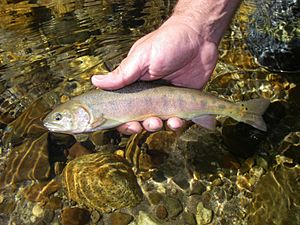Paiute cutthroat trout facts for kids
Quick facts for kids Paiute cutthroat trout |
|
|---|---|
 |
|
| Scientific classification |
|
| Kingdom: | Animalia |
| Phylum: | Chordata |
| Class: | Actinopterygii |
| Order: | Salmoniformes |
| Family: | Salmonidae |
| Genus: | Oncorhynchus |
| Species: | |
| Subspecies: |
O. c. seleniris
|
| Trinomial name | |
| Oncorhynchus clarkii seleniris (John O. Snyder, 1933)
|
|
The Paiute cutthroat trout (Oncorhynchus clarkii seleniris) is a special type of cutthroat trout. There are fourteen different kinds, or subspecies, of cutthroat trout, and this one is unique!
Paiute cutthroat trout live only in Silver King Creek. This creek is a small stream that feeds into the Carson River. It's located high up in the Sierra Nevada mountains in California. The fish gets its name from the Northern Paiute people, who are the native people of that area.
These trout are found only in this specific region. This means they are endemic there, and they are protected within the Carson Ranger District of the Humboldt-Toiyabe National Forest. The Carson River area is part of the Great Basin, which is also where another type of trout, the Lahontan cutthroat trout, used to live.
How the Paiute Cutthroat Trout Became Unique
Scientists believe that a group of Lahontan cutthroat trout got separated in Silver King Creek. This happened because a deep canyon, called Silver King Canyon Gorge, became too difficult for fish to swim up. This likely occurred between 5,000 and 8,000 years ago.
Once separated, these fish started to change over time. They adapted to their new home, which was a very clear and shallow mountain stream. The Lahontan cutthroat trout usually have many spots. But the isolated Paiute trout lost most of their spots. This might have happened because spots made them easier for predators to see in the clear water.
Paiute cutthroat trout also have a unique purple color, while Lahontan cutthroats are more bronze. The Paiute trout learned to eat mostly insects. They also stopped traveling far, because young fish swimming downstream would have gone past the barriers and out of their isolated group.
Protecting the Paiute Cutthroat Trout
In the 1800s, shepherds from the Basque region noticed these unusual trout. By 1912, they had moved some of them to streams above Llewellyn Falls. This was lucky! By 1924, other types of trout, including Lahontan cutthroat trout and rainbow trout, started mixing with the Paiute trout below the falls. This mixing created "cutbows," which are hybrid fish.
Because there were only a few Paiute cutthroat trout in one small area, they were in danger. Things like forest fires, fishing, and mixing with other trout could harm them. To protect them, relatively pure Paiute cutthroat trout were moved. They were placed into almost all the small streams that feed into Silver King Creek above the gorge. They were also moved to Stairway and Sharktooth Creeks in the Sierra Nevada, and to Cottonwood Creek and Cabin Creek in the White Mountains.
The Paiute cutthroat trout was first listed as an endangered species in 1967. This meant it was in great danger of disappearing. In 1975, its status was improved to "threatened." This meant it was still at risk, but not as critically endangered.
Later studies found that even in these new locations, some Paiute cutthroat trout had mixed with other fish. To fix this, scientists sometimes used a special method. They would temporarily stun fish with electricity. This allowed them to catch and examine the fish. Fish that showed more signs of mixing were moved to other areas. The pure Paiute cutthroat trout were returned to the water unharmed.
Fishing is not allowed in most streams where Paiute cutthroat trout live. Future plans include helping the Paiute cutthroat trout expand their living area. This involves removing other types of trout and building barriers to keep them separate.
In 2010, the U.S. Fish & Wildlife Service decided to move forward with a plan. They would remove non-native and hybrid trout from parts of Silver King Creek. Then, they would put pure Paiute cutthroat trout back into their original home. When there are enough Paiute cutthroat trout, they might be taken off the endangered list. At that point, some limited fishing might even be allowed.

